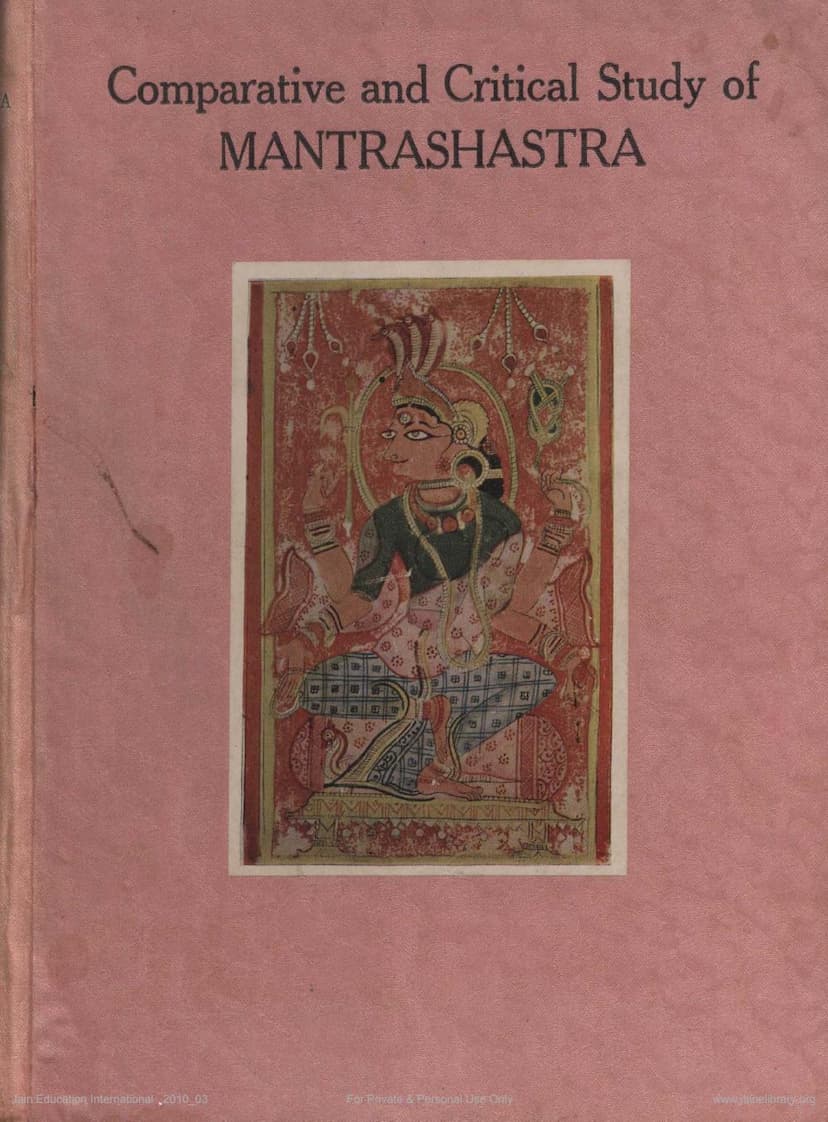Comparative Study Of Mantrashastra
Added to library: September 1, 2025

Summary
This book, "Comparative and Critical Study of Mantrashastra (With Special Treatment of Jain Mantravada)," by Mohanlal Bhagwandas Jhaveri, published in 1000 VS (1944 AD), is a scholarly exploration of Mantrashastra, with a particular focus on its application within Jainism. The author, a BA (Hons) LL.B. Solicitor and accomplished writer, aims to provide a comprehensive and critical examination of the subject, bridging ancient Indian traditions with modern psychological and scientific understanding.
The book's introduction lays out the author's expansive approach, acknowledging that introductions often serve as independent treatises on the subject matter. Jhaveri emphasizes the need to address abstruse topics and conflicting opinions, especially when the utility of such subjects is questioned or their place in scientific discourse is debated. He aims to cater to a well-educated reader familiar with both Eastern and Western thought, while also considering those less familiar with modern concepts.
Key Themes and Chapters Explored:
The detailed table of contents reveals a wide-ranging investigation into the principles and practices associated with Mantrashastra, magic, and spiritual energy. The book delves into:
- The Nature of Magic and Thought-Force: The early chapters explore magic, magical symbolism, and the concept of thought-force, drawing parallels between ancient practices and modern psychology. It discusses how concentration, imagination, desire, and will contribute to mental energy and its potential influence.
- Mentative Energy and Psychic Phenomena: The text examines concepts like telepathy and clairvoyance, referencing Western writers and psychologists like Rudolf Tischner, William Walker Atkinson, and William James to explain phenomena beyond ordinary consciousness and the potential of the subconscious and superconscious mind. It highlights the significance of colors and emotions in human aura and their potential manipulation.
- The Mechanics of Mantras: A significant portion of the book is dedicated to understanding how Mantras function. It discusses the views of Western writers on the potency of sound and intention, contrasting it with the Tantric perspective that Mantras are not merely words but manifestations of divine consciousness. The concept of Shabda Brahman and the role of Kundalini Shakti in Mantra activation are explored.
- Tantric Sadhana and Practices: The book provides an in-depth overview of Tantrik Sadhana, covering its aims and means, the importance of a Guru, various ritualistic elements like Yantra, Mandala, Mudra, Nyasa, Bhutashuddhi, Japa, and Homa. It also discusses the different levels of Sadhana (Pashu, Vira, Divya) and the various Achāras (Vedachara, Dakshinachara, Vamachara).
- Comparative Mysticism: Jhaveri extends his comparative study to include mysticism among Darvishes (Sufism), examining their orders, practices, spiritual powers, and doctrines, drawing parallels with Indian yogic traditions.
- Jain Mantravada: A substantial portion of the book is dedicated to the specific study of Jain Mantravada. It traces the antiquity of Jain Mantras and Mantric literature, linking it to the Pūrva literature and figures like Sri Parsvanatha and Sri Mahāvira. It discusses the role of Vidyadevis, Vidyadharas, Caityavāsis, and the historical development of Jain Mantric practices through various Acharyas like Sri Vajraswami, Sri Kālakācārya, Sri Hemacandrācārya, and Sri Jinadattasūri, among many others.
- Jain Deities and Mantras: The text details the worship of popular Jain deities like Sri Padmavati, Sarasvati, Ambika, and Sri Cakreśvari, explaining their iconography, associated Mantras, and Yantras. It highlights the antiquity of their worship and their significance within Jainism, particularly the connection of Sri Parsvanatha with Mantravāda.
- The 'Sri Bhairava Padmavati Kalpa': The book serves as an introduction to the Sri Bhairava Padmavati Kalpa, explaining its ten chapters which cover the qualifications of a Sadhaka, various rites like Nyasa and Bhutashuddhi, the methods of worship, and the specific Mantras and Yantras associated with Sri Padmavati.
- Appendices: The appendices provide detailed textual analysis and include hymns, mantras, and descriptions of Yantras related to various Jain deities like Padmavati, Sarasvati, Ambika, and Cakreśvari, as well as discussions on the historical context and authenticity of Jain Mantric texts.
Key Arguments and Observations:
- Thought-Force and Psychology: Jhaveri argues that modern psychology provides corroboration for ancient beliefs about "thought-force" and mental energy, suggesting that concentrated thought, imbued with emotion, can influence reality.
- Mantra's Efficacy: The book posits that Mantras are not just words but possess inherent power, a Shakti, that acts through sound and consciousness. The efficacy of a Mantra is tied to the Sadhaka's concentration, visualization, and the deity associated with it.
- Jain Mantravada's Antiquity: The author strongly argues for the ancient origins of Jain Mantravāda, tracing its roots to the Pūrvas and connecting it to the lineage of Tirthankaras, particularly Sri Parsvanatha.
- Reconciliation of Mantravada with Karma Philosophy: Jhaveri addresses the apparent contradiction between the Jain emphasis on Karma philosophy and the practice of Mantravāda, explaining that deities are seen as manifestations of divine consciousness and their worship can aid in spiritual upliftment and the purification of the mind, thus indirectly supporting the path to salvation.
- Caityavasi Influence: The book discusses the historical development and practices of Caityavāsis (monks residing in temples) and their potential laxity, arguing that this trend, along with other socio-historical factors, contributed to the emphasis on Mantric practices for protection and influence.
- Comparative Approach: A significant aspect of the book is its comparative analysis, drawing connections between Jain Mantravāda and practices in Hinduism, Buddhism, and even Sufism, highlighting universal principles of spiritual pursuit.
- Critique of Western Interpretations: Jhaveri critically examines Western interpretations of Tantra, often dismissing them as misunderstandings of black magic and erotic mysticism, and asserts the need for a deeper, more informed understanding.
In essence, "Comparative and Critical Study of Mantrashastra" is a meticulous scholarly work that seeks to demystify and legitimize the study of Mantrashastra, particularly within the Jain tradition, by grounding it in psychological principles, historical evidence, and a comparative analysis of various spiritual disciplines. It highlights the rich and ancient heritage of Mantravāda within Jainism, presenting it as an integral aspect of self-realization and spiritual pursuit.